Page 378 of 435
377 Technical data
Spare parts service
Warranty coverage
Identification labels
Layout of poly-V-belt drive
Engine
Rims and tires
Electrical system
Main dimensions and weights
Weights
Fuels, coolants, lubricants, etc.
Consumer information
Page 379 of 435
378 Technical dataSpare parts service
�The “Technical data” section provides the
necessary technical data for your vehicle.
Spare parts service
All authorized Mercedes-Benz Centers
maintain a stock of genuine
Mercedes-Benz parts required for mainte-
nance and repair work. In addition, strate-
gically located parts distribution centers
provide quick and reliable parts service.
More than 300 000 different spare parts
for Mercedes-Benz models are available.
Genuine Mercedes-Benz parts are subject-
ed to stringent quality inspections. Each
part has been specifically developed, man-
ufactured or selected for and adapted to
Mercedes-Benz vehicles.
Therefore, genuine Mercedes-Benz parts
should be installed.
!The use of non-genuine Mercedes-Benz
parts and accessories not authorized
by Mercedes-Benz could damage the
vehicle, which is not covered by the
Mercedes-Benz Limited Warranty, or
could compromise the vehicle’s dura-
bility or safety.
Page 380 of 435
379 Technical data
Warranty coverage
�Warranty coverage
Your vehicle is covered under the terms of
the warranties printed in the Service and
Warranty Information booklet. Your
authorized Mercedes-Benz Center will ex-
change or repair any defective parts origi-
nally installed on the vehicle in accordance
with the terms of the following warranties:�
New Vehicle Limited Warranty
�
Emission System Warranty
�
Emission Performance Warranty
�
California, Maine, Massachusetts, and
Vermont Emission Control Systems
WarrantyReplacement parts and accessories are
covered by the Mercedes-Benz Spare Parts
and Accessories warranties, copies of
which are available at any authorized
Mercedes-Benz Center.Loss of Service and Warranty
Information Booklet
Should you lose your Service and Warranty
Information booklet, have an authorized
Mercedes-Benz Center arrange for a re-
placement. It will be mailed to you.
Page 394 of 435
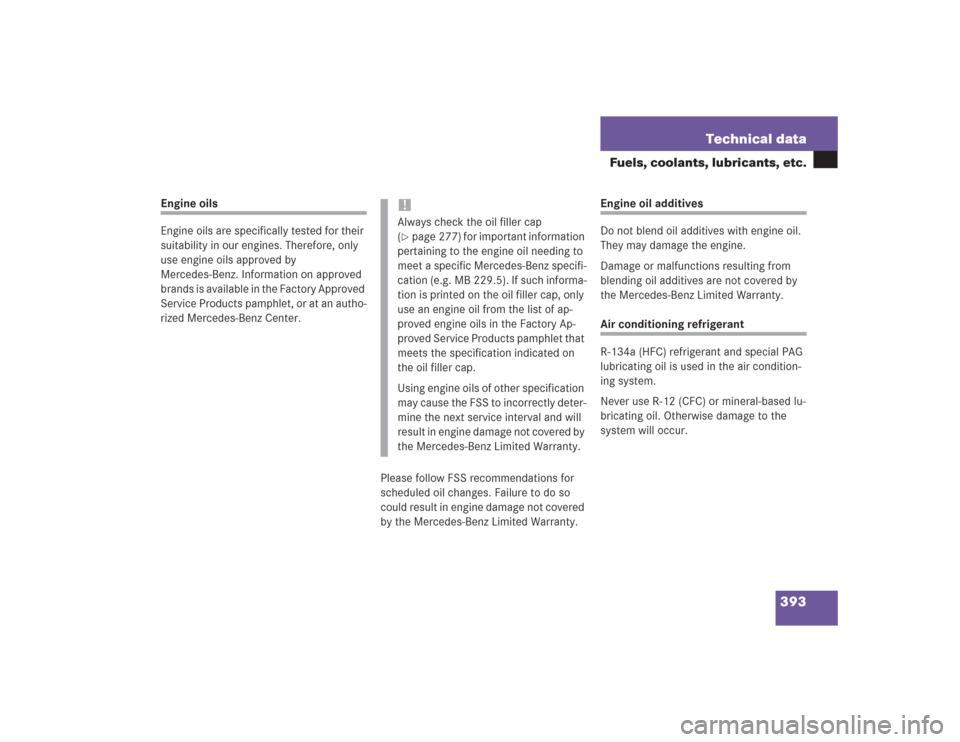
393 Technical data
Fuels, coolants, lubricants, etc.
Engine oils
Engine oils are specifically tested for their
suitability in our engines. Therefore, only
use engine oils approved by
Mercedes-Benz. Information on approved
brands is available in the Factory Approved
Service Products pamphlet, or at an autho-
rized Mercedes-Benz Center.
Please follow FSS recommendations for
scheduled oil changes. Failure to do so
could result in engine damage not covered
by the Mercedes-Benz Limited Warranty.
Engine oil additives
Do not blend oil additives with engine oil.
They may damage the engine.
Damage or malfunctions resulting from
blending oil additives are not covered by
the Mercedes-Benz Limited Warranty.Air conditioning refrigerant
R-134a (HFC) refrigerant and special PAG
lubricating oil is used in the air condition-
ing system.
Never use R-12 (CFC) or mineral-based lu-
bricating oil. Otherwise damage to the
system will occur.
!Always check the oil filler cap
(�page 277) for important information
pertaining to the engine oil needing to
meet a specific Mercedes-Benz specifi-
cation (e.g. MB 229.5). If such informa-
tion is printed on the oil filler cap, only
use an engine oil from the list of ap-
proved engine oils in the Factory Ap-
proved Service Products pamphlet that
meets the specification indicated on
the oil filler cap.
Using engine oils of other specification
may cause the FSS to incorrectly deter-
mine the next service interval and will
result in engine damage not covered by
the Mercedes-Benz Limited Warranty.
Page 397 of 435
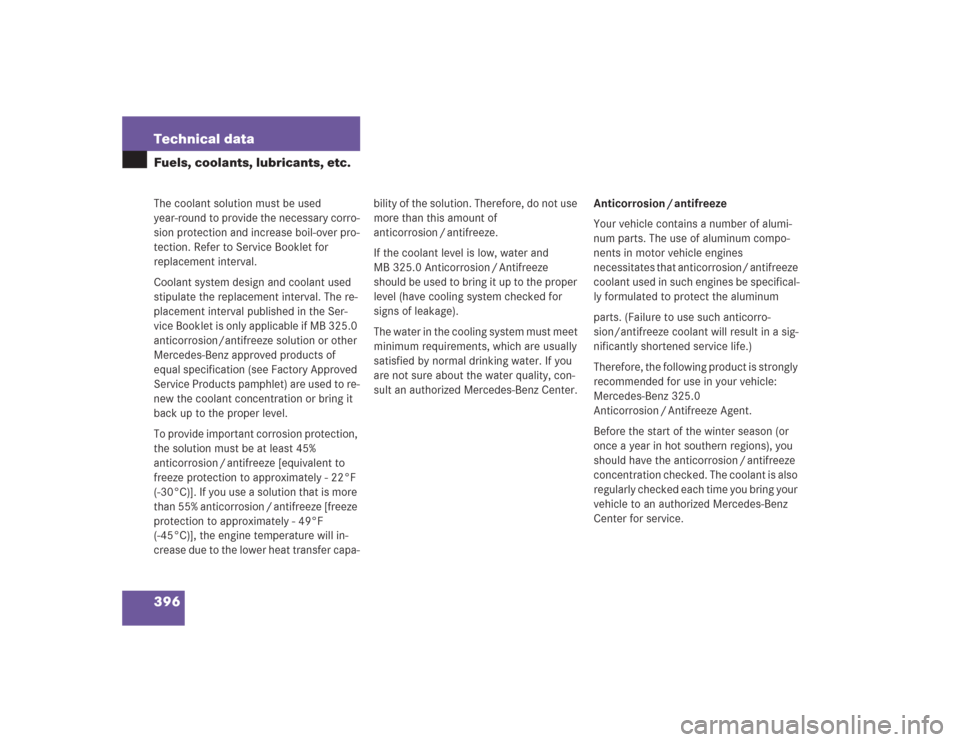
396 Technical dataFuels, coolants, lubricants, etc.The coolant solution must be used
year-round to provide the necessary corro-
sion protection and increase boil-over pro-
tection. Refer to Service Booklet for
replacement interval.
Coolant system design and coolant used
stipulate the replacement interval. The re-
placement interval published in the Ser-
vice Booklet is only applicable if MB 325.0
anticorrosion/antifreeze solution or other
Mercedes-Benz approved products of
equal specification (see Factory Approved
Service Products pamphlet) are used to re-
new the coolant concentration or bring it
back up to the proper level.
To provide important corrosion protection,
the solution must be at least 45%
anticorrosion / antifreeze [equivalent to
freeze protection to approximately - 22°F
(-30°C)]. If you use a solution that is more
than 55% anticorrosion / antifreeze [freeze
protection to approximately - 49°F
(-45°C)], the engine temperature will in-
crease due to the lower heat transfer capa-bility of the solution. Therefore, do not use
more than this amount of
anticorrosion / antifreeze.
If the coolant level is low, water and
MB 325.0 Anticorrosion / Antifreeze
should be used to bring it up to the proper
level (have cooling system checked for
signs of leakage).
The water in the cooling system must meet
minimum requirements, which are usually
satisfied by normal drinking water. If you
are not sure about the water quality, con-
sult an authorized Mercedes-Benz Center.Anticorrosion / antifreeze
Your vehicle contains a number of alumi-
num parts. The use of aluminum compo-
nents in motor vehicle engines
necessitates that anticorrosion/ antifreeze
coolant used in such engines be specifical-
ly formulated to protect the aluminum
parts. (Failure to use such anticorro-
sion/antifreeze coolant will result in a sig-
nificantly shortened service life.)
Therefore, the following product is strongly
recommended for use in your vehicle:
Mercedes-Benz 325.0
Anticorrosion / Antifreeze Agent.
Before the start of the winter season (or
once a year in hot southern regions), you
should have the anticorrosion / antifreeze
concentration checked. The coolant is also
regularly checked each time you bring your
vehicle to an authorized Mercedes-Benz
Center for service.
Page 400 of 435
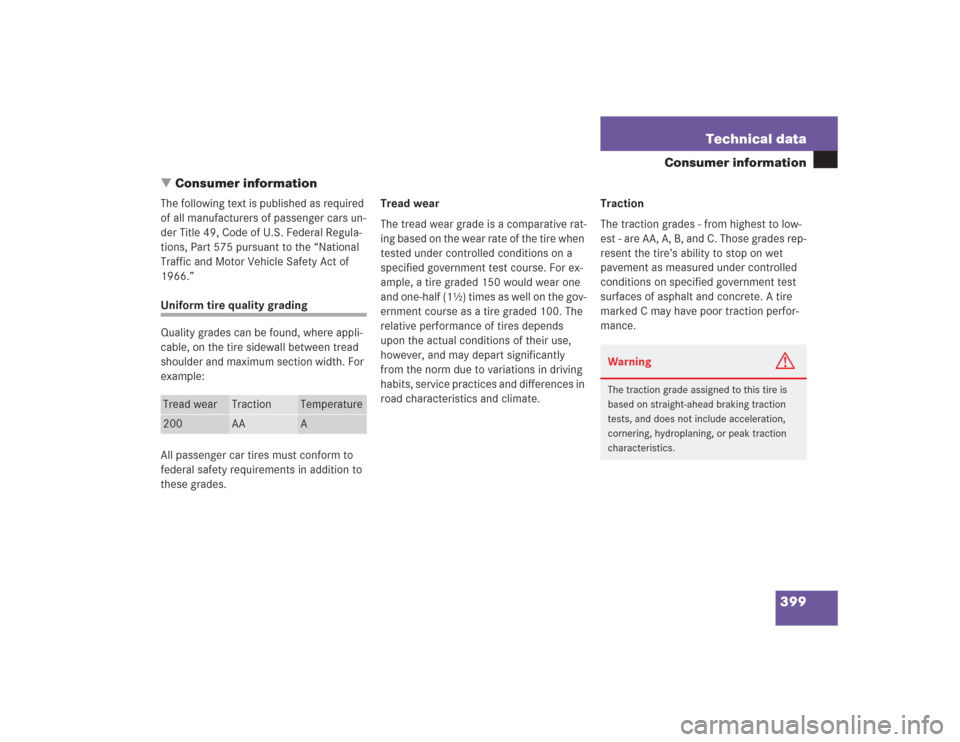
399 Technical data
Consumer information
�Consumer information
The following text is published as required
of all manufacturers of passenger cars un-
der Title 49, Code of U.S. Federal Regula-
tions, Part 575 pursuant to the “National
Traffic and Motor Vehicle Safety Act of
1966.”Uniform tire quality grading
Quality grades can be found, where appli-
cable, on the tire sidewall between tread
shoulder and maximum section width. For
example:
All passenger car tires must conform to
federal safety requirements in addition to
these grades.Tread wear
The tread wear grade is a comparative rat-
ing based on the wear rate of the tire when
tested under controlled conditions on a
specified government test course. For ex-
ample, a tire graded 150 would wear one
and one-half (1½) times as well on the gov-
ernment course as a tire graded 100. The
relative performance of tires depends
upon the actual conditions of their use,
however, and may depart significantly
from the norm due to variations in driving
habits, service practices and differences in
road characteristics and climate.Traction
The traction grades - from highest to low-
est - are AA, A, B, and C. Those grades rep-
resent the tire’s ability to stop on wet
pavement as measured under controlled
conditions on specified government test
surfaces of asphalt and concrete. A tire
marked C may have poor traction perfor-
mance.Tread wear
Traction
Temperature
200
AA
A
Warning
G
The traction grade assigned to this tire is
based on straight-ahead braking traction
tests, and does not include acceleration,
cornering, hydroplaning, or peak traction
characteristics.
Page 403 of 435
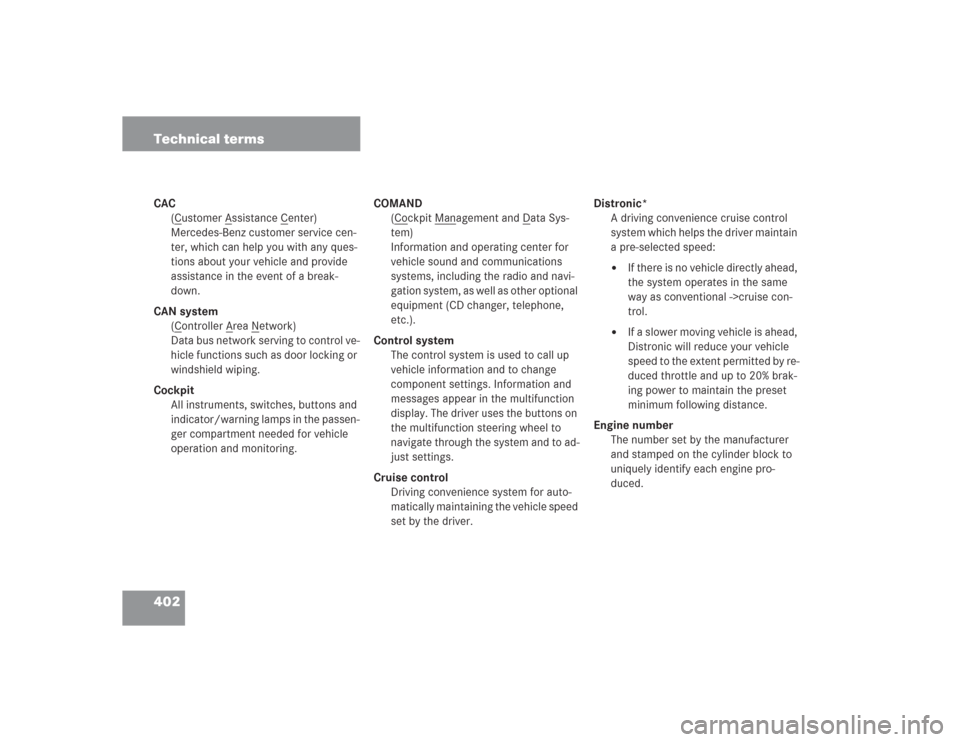
402 Technical termsCAC
(C
ustomer A
ssistance C
enter)
Mercedes-Benz customer service cen-
ter, which can help you with any ques-
tions about your vehicle and provide
assistance in the event of a break-
down.
CAN system
(C
ontroller A
rea N
etwork)
Data bus network serving to control ve-
hicle functions such as door locking or
windshield wiping.
Cockpit
All instruments, switches, buttons and
indicator/warning lamps in the passen-
ger compartment needed for vehicle
operation and monitoring.COMAND
(C
ockpit M
anagement and D
ata Sys-
tem)
Information and operating center for
vehicle sound and communications
systems, including the radio and navi-
gation system, as well as other optional
equipment (CD changer, telephone,
etc.).
Control system
The control system is used to call up
vehicle information and to change
component settings. Information and
messages appear in the multifunction
display. The driver uses the buttons on
the multifunction steering wheel to
navigate through the system and to ad-
just settings.
Cruise control
Driving convenience system for auto-
matically maintaining the vehicle speed
set by the driver.Distronic*
A driving convenience cruise control
system which helps the driver maintain
a pre-selected speed:
�
If there is no vehicle directly ahead,
the system operates in the same
way as conventional ->cruise con-
trol.
�
If a slower moving vehicle is ahead,
Distronic will reduce your vehicle
speed to the extent permitted by re-
duced throttle and up to 20% brak-
ing power to maintain the preset
minimum following distance.
Engine number
The number set by the manufacturer
and stamped on the cylinder block to
uniquely identify each engine pro-
duced.
Page 404 of 435
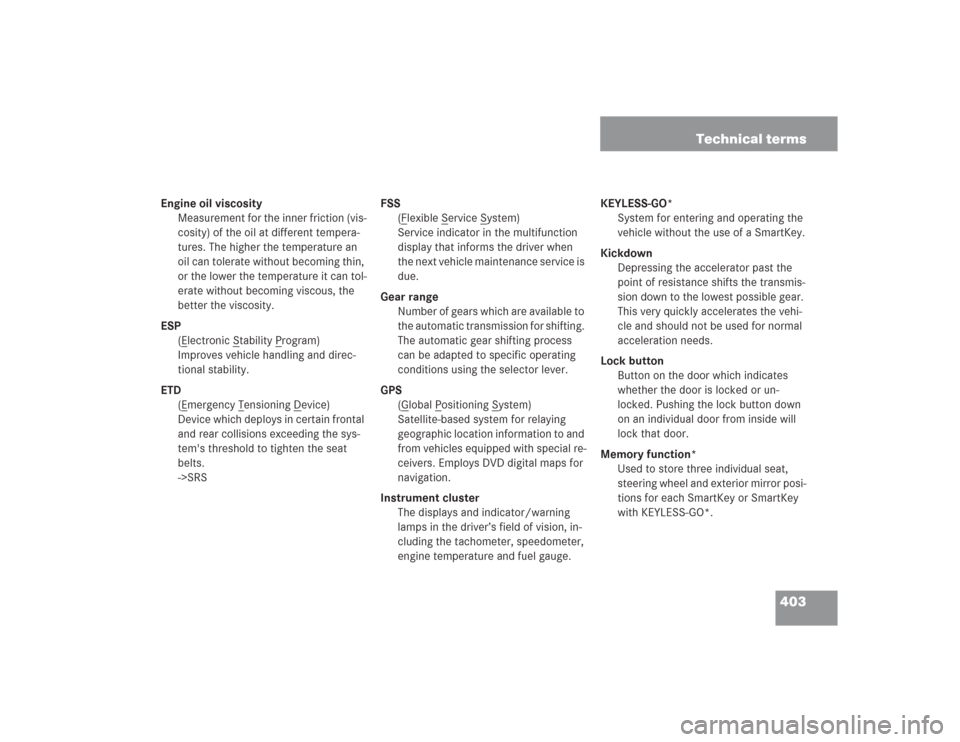
403 Technical terms
Engine oil viscosity
Measurement for the inner friction (vis-
cosity) of the oil at different tempera-
tures. The higher the temperature an
oil can tolerate without becoming thin,
or the lower the temperature it can tol-
erate without becoming viscous, the
better the viscosity.
ESP
(E
lectronic S
tability P
rogram)
Improves vehicle handling and direc-
tional stability.
ETD
(E
mergency T
ensioning D
evice)
Device which deploys in certain frontal
and rear collisions exceeding the sys-
tem's threshold to tighten the seat
belts.
->SRSFSS
(F
lexible S
ervice S
ystem)
Service indicator in the multifunction
display that informs the driver when
the next vehicle maintenance service is
due.
Gear range
Number of gears which are available to
the automatic transmission for shifting.
The automatic gear shifting process
can be adapted to specific operating
conditions using the selector lever.
GPS
(G
lobal P
ositioning S
ystem)
Satellite-based system for relaying
geographic location information to and
from vehicles equipped with special re-
ceivers. Employs DVD digital maps for
navigation.
Instrument cluster
The displays and indicator/warning
lamps in the driver’s field of vision, in-
cluding the tachometer, speedometer,
engine temperature and fuel gauge.KEYLESS-GO*
System for entering and operating the
vehicle without the use of a SmartKey.
Kickdown
Depressing the accelerator past the
point of resistance shifts the transmis-
sion down to the lowest possible gear.
This very quickly accelerates the vehi-
cle and should not be used for normal
acceleration needs.
Lock button
Button on the door which indicates
whether the door is locked or un-
locked. Pushing the lock button down
on an individual door from inside will
lock that door.
Memory function*
Used to store three individual seat,
steering wheel and exterior mirror posi-
tions for each SmartKey or SmartKey
with KEYLESS-GO*.